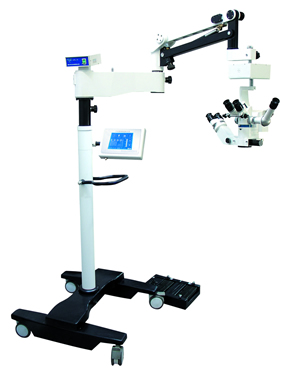|
We specialize in
manufacture that Ophthalmic surgical microscope.
We sell
Ophthalmic surgical
microscope.
ĪĪ |
|
Model LZL-16
Operation microscope for ophthalmology
(ophthalmic surgical
microscope, ophthalmological,
ophthalmology,operation,operating)
ĪĪ |

LZL-16
operation microscope (Ophthalmic
surgical microscope, Ophthalmological,operation,
ophthalmology,operating) is of our latest design for
ophthalmic surgery. Equipped with advanced motorized
continuous zoom, the instrument can realize stepless
magnification during the operation. The assistant scopes
have three levels of magnification, and can be turned round
the main scopes within 180ĪŃ and can be fixed at any angle.
Its camera and presenting facilities are useful for teaching
and image storage, and video camera system is optional to
customers. Its reliability and functionality can meet
various requirements in ophthalmic(Ophthalmic
surgical microscope, Ophthalmological,operation,
ophthalmology,operating) surgeries.
Features
1. The main and assistant scopes share the same light route
2. Light systems is equipped with retina protection device,
red reflex intensifier, and filter of infrared.
3. It adopts 28 inclined illumination device which can be
used for slit illumination ,slit can revolve round the
optical axis within 360 degree
4. The main scopes(ophthalmology,ophthalmic
surgical microscope,operation,
Ophthalmological
Operating)adopts motorized continuous zoom system,
with the magnification adjustable from 5X to 25X, and the
instrument enjoys a clear image, a sharp stereoscopic
perception and remarkable width of view field.
5. The assistant scopes possess the step magnification of
4X, 10X, 16X, by hand wheel. It can also revolve round the
main scopes
(Ophthalmology, Ophthalmic
surgical microscope, Operation,
Ophthalmological
Operating) within 180 degree and can be fixed at any angle.
6. X-Y plane movement through push button and the moving
range:40mm
7. Equipped with motorized bending or lifting adjustment, it
is convenient for doctor to operate
8. The stand adopts spring counter balance at every fixed
point for easy operation
Main specifications:
(Ophthalmology, Operation,
Ophthalmological
Operating)
Magnification of main scopes:5x-25x
View field of main scopes:42.5-8.5mm
Magnification of assistant scopes:6x,10x,16x
View field of assistant scopes:35mm,21mm,17mm
Stands vertical movement range of:500mm
Fine adjustment focusing range:50mm
Range of ocular distance:55-72mm
The max. stretching length of stands cross arm:1030mm
The swing angle of carries arm:240 degree
Power source: AC 220VĪ└5%/50hz or AC 110VĪ└5% /50hz
ĪĪ
|
|
Program Requirements for
Fellowship Education in Ophthalmic Pathology and Ocular
Oncology
(Ophthalmic
surgical microscope, Ophthalmological,operation,
ophthalmology,operating)
I.Introduction
A.Definition and Scope
Ophthalmic
(Ophthalmic
surgical microscope, Ophthalmological,operation,
ophthalmology, operating)
pathology is a
subspecialty of Pathology and Ophthalmology. Ocular oncology
is a subspecialty of ophthalmology
(Ophthalmic
surgical microscope, Ophthalmological,operation,
ophthalmology,operating). fellowship is
designed to provide an advanced level of competence in
processing and interpretation of eye pathology specimens as
well as the medical and surgical(Ophthalmic
surgical microscope,Ophthalmological,operation,
ophthalmology, operating) care of ocular oncology
patients. These two areas complement one another, and it
will be possible to complete within one year a fellowship in
either advanced ophthalmic pathology or ocular oncology
training or a combination of both. The goal of the
subspecialty training in ophthalmic
(Ophthalmic
surgical microscope, Ophthalmological,
Operation,
Ophthalmology, Operating) pathology is to enhance
knowledge gained in ophthalmology or anatomic pathology
residency training by providing exposure to gross and
microscopic examination of ophthalmic
(Ophthalmic
surgical microscope, Ophthalmological,
Operation,
Ophthalmology, Operating) tissue. Experience is
provided for assuming responsibility for rendering an
interpretation of ocular tissues. The goal of the
subspecialty training in ocular oncology is to enhance
knowledge gained in ophthalmology(ophthalmic
surgical microscope,Ophthalmology, ophthalmological,
Operation,
Operating) residency training with
medical and care of ocular oncology patients. A
clinical or basic science research component of the
fellowship may be included.
B.Duration and Scope of Education
1.Admission prerequisites: fellows admitted to the pathology
portion of the program must have completed a US equivalent
residency in ophthalmology or anatomic pathology and those
admitted to the oncology portion of the program must have
completed a residency in US equivalent ophthalmology
( Ophthalmic
surgical microscope, Ophthalmology, Operation,
Operating
ophthalmological).
2.The pathology portion of the fellowship must occupy at
least 50% of the fellowĪ»s allotted time for a minimum of 1
year and the oncology portion of the fellowship must occupy
at least 50% of the fellowĪ»s allotted time for a minimum of
1 year.
3.Three options will be available, each including a minimum
of the following
a.Six months of ophthalmic pathology training (option IB3a)
b.Six months of ocular oncology training (option IB3b)
c.Combined six months of ophthalmic
(Ophthalmology,
Ophthalmic
surgical microscope, Operation,
Ophthalmological
Operating) pathology and six months
of ocular oncology (option IB3c)
4.The minimum ophthalmic
(ophthalmic
surgical microscope,ophthalmology,operation,operating
ophthalmological) pathology and ocular oncology
training duration may run concurrently (i.e. half time
pathology/half time oncology)for one year or consecutively(i.e.6 months of full time pathology and 6 months of
full®\time ocular oncology)(
Ophthalmic
surgical microscope, Ophthalmology, Operation,
Operating
ophthalmological).
5.The pathology portion of the fellowship may include but is
not limited to a combination of anatomic pathology, cytology
,experimental pathology and clinicopathologic correlation.
The oncology portion of the fellowship may include but is
not limited to the medical and care of patients
with retinoblastoma, uveal melanoma, other intraocular
tumors and conjunctival
(
Ophthalmic
surgical microscope, Ophthalmology, Operation,
Operating
ophthalmological) tumors.
6.Prior to entry in the program, each fellow must be
notified in writing of the required length of the program.
II.Institutional Support
A.Sponsoring Institution
One sponsoring institution must assume the ultimate
responsibility of the program, and this responsibility
extends to fellow assignments at all participating
institutions. Fellowship programs in ophthalmic(Ophthalmic
surgical microscope, Ophthalmology, Operation,
Operating
ophthalmological) pathology/ocular oncology should be in institutes that
sponsor Accreditation Council for Graduate Medical Education
(ACGME)®\accredited residency programs in ophthalmology and
pathology or that are affiliated with such residencies.
B.Participating Institutions
1.Assignments to participating institutions must be based on
a clear educational rationale, must have clearly stated
learning objectives and activities, and should provide
resources not otherwise available to the program.
2.Assignments at participating institutions must be of
sufficient length to ensure a quality education experience
and should provide sufficient opportunity
(Ophthalmology,
Ophthalmic
surgical microscope, Operation,
Operating
ophthalmological) for continuity of
care. Although the number of participating institutions may
vary with the various specialtiesĪ» needs, all participating
institutions must demonstrate the ability to promote the
program goals, education and peer activities. Exceptions
must be justified and prior®\approved.
3.For the ophthalmic pathology portion of the fellowship,
participating institutions must have the approval of the
chairperson of the Departmentof Ophthalmology
(Ophthalmic
surgical microscope, Ophthalmology, Operation,
Operating
ophthalmological) or Pathology
and for the ocular oncology portion of the fellowship,
approval of the chairperson of the Department of
Ophthalmology.
C.Facilities and Resources
1.Clinical Environment
Adequate space and equipment must be available for the
conduct of the program, including meeting rooms, classrooms,
and office and research space for staff.
2.Facilities
Desk and laboratory space must be provided for the pathology
and oncology fellows. A microscope
(Ophthalmology,
Ophthalmic
surgical microscope, Operation,
Ophthalmological
Operating) must be provided for
pathology fellows.
3.Library
a.Fellows must have ready access to a major medical library,
either at the Institution where the fellows are located, or
through an arrangement with convenient nearby institutions.
b.Library services should include an on®\site library or a
collection of ophthalmology(Ophthalmology,
Ophthalmic
surgical microscope, Operation,
Ophthalmological
Operating), pathology,
ophthalmic pathology, and ocular oncology medical texts,
journals, as well as ready access to internet®\based
materials.
Article Source:http://www.aupofcc.org/subspecialties/pathology/pathology_guidelines.pdf |



